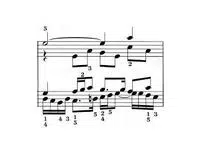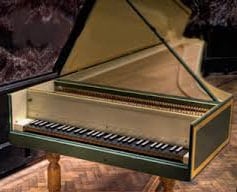 The concept of counterpoint , which derives from the Latin contrapunctus , is used in the field of music to name the harmonious combination established by opposing voices or different melodies .
The concept of counterpoint , which derives from the Latin contrapunctus , is used in the field of music to name the harmonious combination established by opposing voices or different melodies .
As a compositional technique, counterpoint studies the link between different voices to achieve a harmonic balance . The trend began to develop in the 15th century and prevailed in the majority of compositions made in the Western world, extending to the present day.
It can be said that counterpoint is committed to combining musical lines that have a very different sound but that, when played simultaneously, achieve harmony . Musical writing according to counterpoint requires that certain rules be respected to achieve the intended harmony.
Chamber music , for example, usually uses four voices: soprano, alto, tenor and bass. Through the rules of counterpoint, these voices maintain independence although, at the same time, they sound in harmony .
From a historical point of view, counterpoint has incalculable importance in Western music, which began in the Middle Ages. Throughout the Renaissance, it underwent an especially strong development, and came to have a predominant role during the Baroque, Classicism and Romanticism, although little by little it lost relevance compared to other composition techniques .
We can say that over time composers crowned harmony as the most important organizing principle. Broadly speaking, harmony is associated with the linking of notes simultaneously to form chords, and this is reflected in a "vertical" writing (in the staff the notes are placed on top of each other), in a way opposite to what happens with the melody , which develops in a "horizontal" direction.
During the Renaissance, two of the composers worth highlighting when looking for examples of counterpoint are Palestrina and Orlando di Lasso ; The first was originally from Italy and is considered the master of counterpoint, while the second, Franco-Flemish, was the leader of the Roman school.
It was at the end of the Baroque that, according to experts, counterpoint approached perfection, especially through the works of the acclaimed Johann Sebastian Bach , including Musical Offering , The Art of the Fugue and The Well-Tempered Clavier .
Bach's influence can be seen in the so-called illustrated counterpoint , particularly in the legacy of Wolfgang Amadeus Mozart , who took advantage of this composition technique in many of his latest creations, such as his Haydian quartets , composed between 1782 and 1785. Ludwig van Beethoven and Franz Joseph Haydn are also noted for their use of counterpoint.
 Already in romanticism we have the works of Johannes Brahms , who is said to have turned to counterpoint to combat boredom. His Deutsches Requiem is a clear example of the use he made of the fugue ; It is a work for soprano, baritone, choir and orchestra that meditates on life and death based on biblical scriptures.
Already in romanticism we have the works of Johannes Brahms , who is said to have turned to counterpoint to combat boredom. His Deutsches Requiem is a clear example of the use he made of the fugue ; It is a work for soprano, baritone, choir and orchestra that meditates on life and death based on biblical scriptures.
In some South American countries , the challenge or confrontation of two or more poets or popular singers is called counterpoint. Counterpoints are common among payadores, to cite one case.
For colloquial language , a counterpoint is a contrast or opposition that arises between two elements that exist or are produced simultaneously: "The bill generated a counterpoint between rural producers and the government," "The actions of the local group "It provoked a counterpoint of emotions in the public" , "Counterpoint between the president's statements and the statements of the Minister of Economy" .
«Counterpoint» , finally, is the title with which the novel «Point Counter Point» by the Englishman Aldous Huxley was published in our language.
